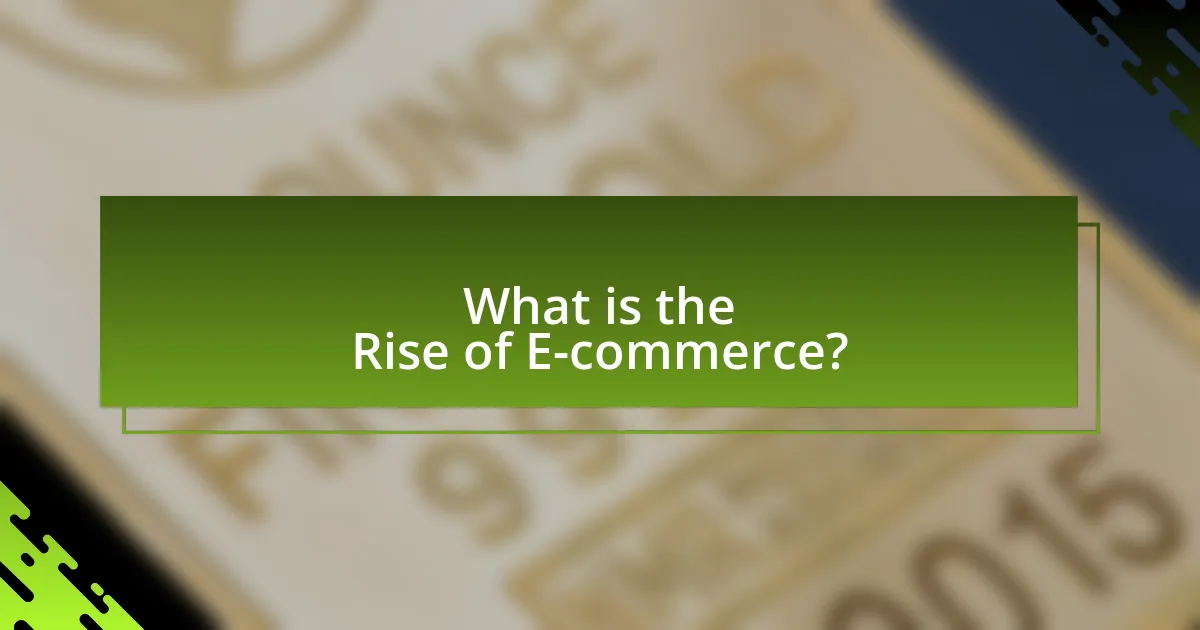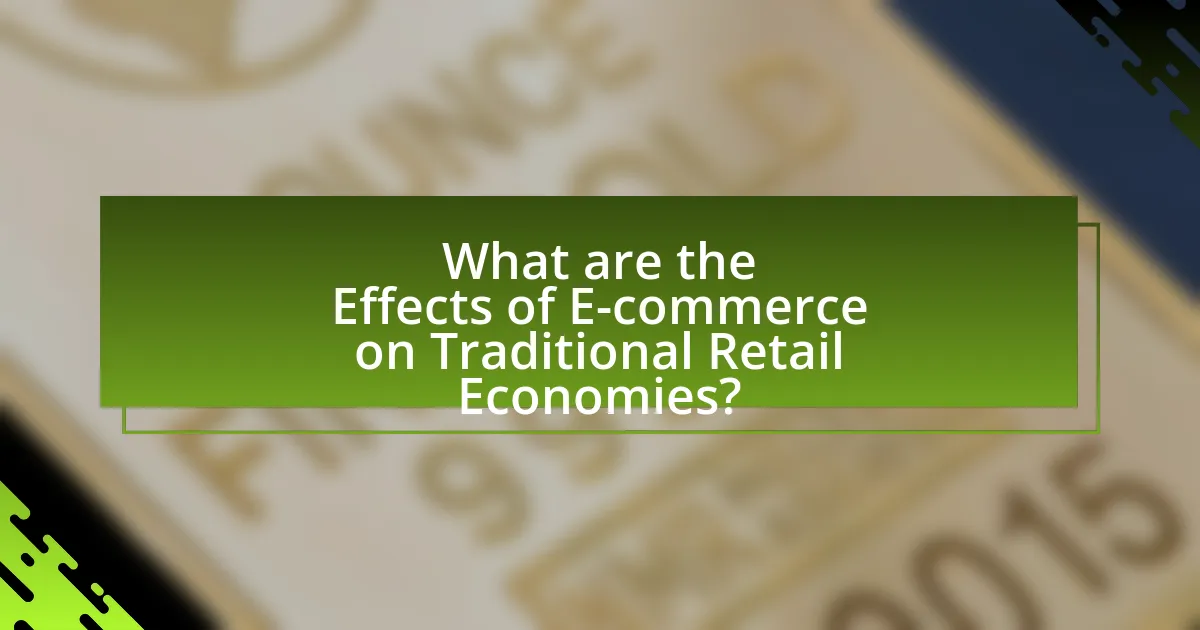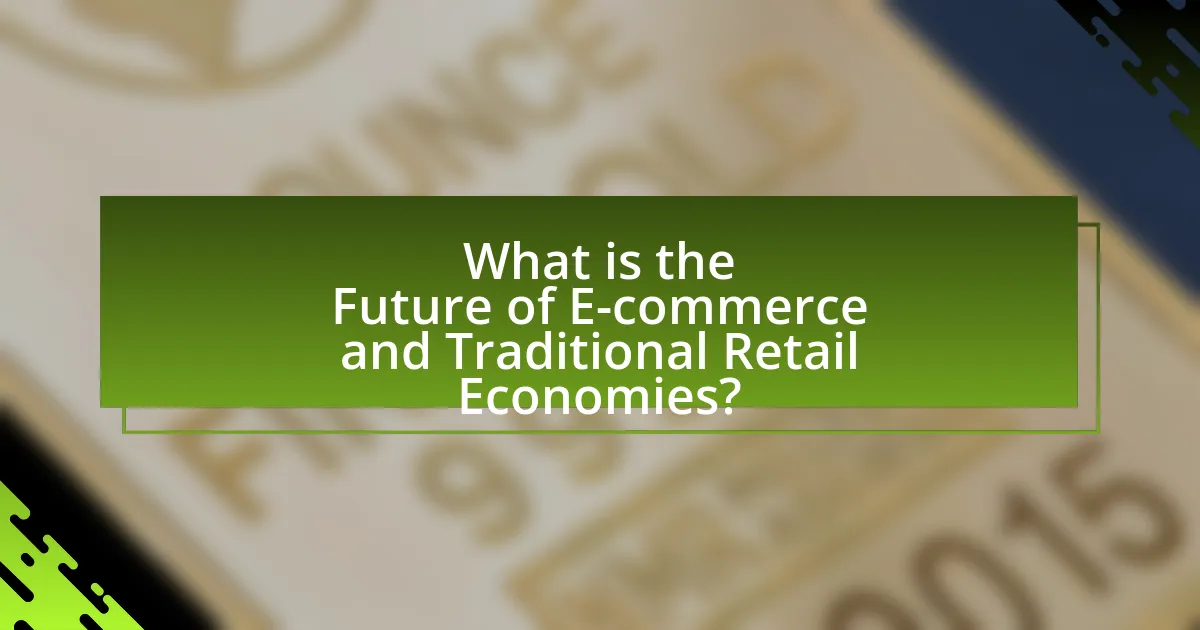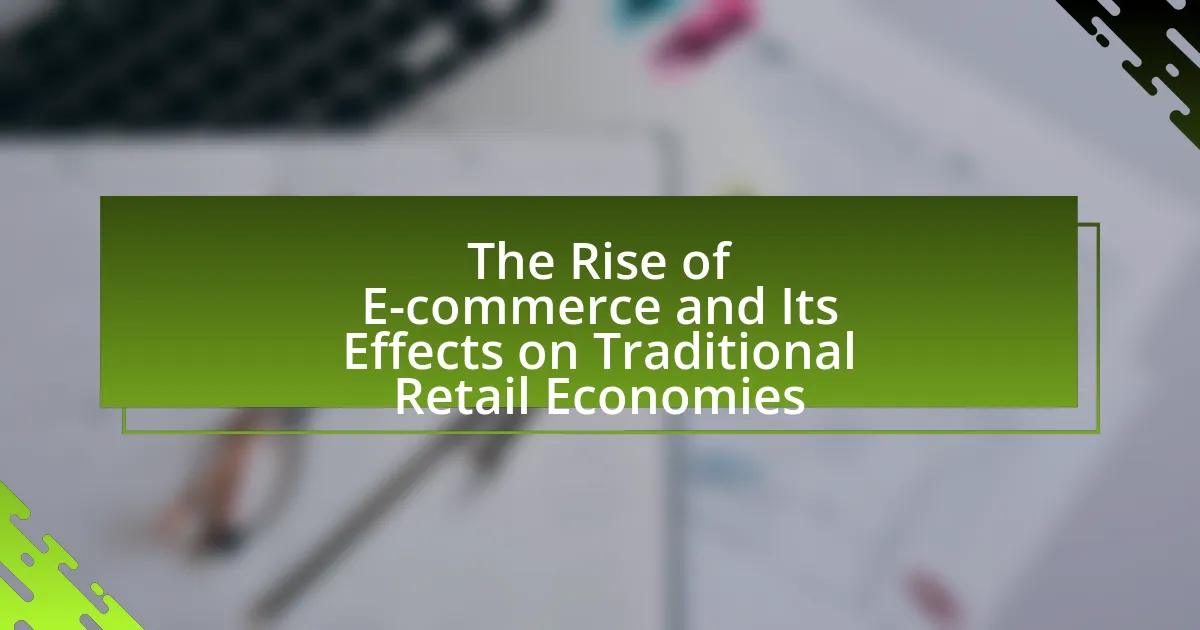The article examines the rise of e-commerce and its profound effects on traditional retail economies. It outlines the evolution of e-commerce from basic online catalogs to complex platforms, driven by technological advancements and changing consumer behaviors. Key components of e-commerce, such as payment systems, logistics, and various business models, are discussed, alongside the impact of mobile commerce and social media on shopping habits. The article also highlights the challenges faced by traditional retailers, including increased competition and pricing pressures, while exploring opportunities for adaptation through omnichannel strategies and data analytics. Finally, it addresses future trends in e-commerce and the necessary operational changes for traditional retailers to remain competitive in a digital landscape.

What is the Rise of E-commerce?
The rise of e-commerce refers to the significant growth and adoption of online shopping platforms, which has transformed the retail landscape. This shift began in the late 1990s and has accelerated due to advancements in technology, increased internet accessibility, and changing consumer behaviors. For instance, global e-commerce sales reached approximately $4.28 trillion in 2020 and are projected to grow to $5.4 trillion by 2022, according to Statista. This growth has led to a decline in traditional retail sales, as consumers increasingly prefer the convenience and variety offered by online shopping.
How has E-commerce evolved over the years?
E-commerce has evolved significantly over the years, transitioning from simple online catalogs to complex platforms facilitating global transactions. Initially, in the 1990s, e-commerce was characterized by basic websites that allowed businesses to display products and accept orders via email or phone. The introduction of secure payment systems, such as SSL encryption, in the mid-1990s enabled safer online transactions, leading to increased consumer trust.
By the early 2000s, the rise of online marketplaces like Amazon and eBay transformed e-commerce into a more interactive and competitive environment, allowing consumers to compare prices and read reviews. The advent of mobile technology in the late 2000s further accelerated e-commerce growth, with mobile shopping apps and responsive websites making online shopping more accessible.
In recent years, the integration of artificial intelligence and machine learning has personalized the shopping experience, while social media platforms have become vital channels for e-commerce, enabling direct sales through social commerce. According to Statista, global e-commerce sales reached approximately $4.28 trillion in 2020, highlighting its substantial impact on traditional retail economies. This evolution has led to a shift in consumer behavior, with many preferring online shopping over physical stores, thereby reshaping the retail landscape.
What technological advancements have driven E-commerce growth?
Technological advancements such as the proliferation of high-speed internet, mobile devices, and secure payment systems have significantly driven E-commerce growth. High-speed internet has enabled seamless online shopping experiences, allowing consumers to browse and purchase products quickly. The widespread adoption of smartphones has facilitated mobile commerce, with over 50% of E-commerce transactions now occurring on mobile devices. Additionally, advancements in secure payment technologies, including encryption and digital wallets, have increased consumer trust, leading to higher conversion rates. These factors collectively contribute to the rapid expansion of E-commerce, evidenced by a global market size that reached approximately $4.28 trillion in 2020 and is projected to grow further.
How have consumer behaviors changed in relation to E-commerce?
Consumer behaviors have shifted significantly towards E-commerce, with increased preference for online shopping over traditional retail. A 2022 report by Statista indicated that global E-commerce sales reached approximately $5.2 trillion, reflecting a 15% increase from the previous year, demonstrating a growing reliance on digital platforms for purchasing. Additionally, consumers now prioritize convenience, with 70% of shoppers indicating they prefer the ease of online transactions, as reported by the National Retail Federation. This trend is further evidenced by the rise in mobile shopping, where 54% of consumers use smartphones for purchases, highlighting a shift towards mobile-first shopping experiences.
What are the key components of E-commerce?
The key components of E-commerce include online storefronts, payment gateways, logistics and supply chain management, customer service, and digital marketing. Online storefronts serve as the virtual platforms where products or services are displayed and sold, while payment gateways facilitate secure transactions between customers and merchants. Logistics and supply chain management ensure the efficient delivery of goods, and customer service addresses inquiries and issues, enhancing user experience. Digital marketing strategies, such as SEO and social media advertising, drive traffic to E-commerce sites and increase sales. These components collectively enable E-commerce businesses to operate effectively in a competitive market.
What types of E-commerce models exist?
There are several types of e-commerce models, including Business-to-Consumer (B2C), Business-to-Business (B2B), Consumer-to-Consumer (C2C), Consumer-to-Business (C2B), and Business-to-Government (B2G). B2C involves businesses selling directly to consumers, exemplified by online retailers like Amazon. B2B refers to transactions between businesses, such as wholesalers selling to retailers. C2C encompasses consumer sales to other consumers, often facilitated by platforms like eBay. C2B allows consumers to sell products or services to businesses, as seen in freelance platforms. Lastly, B2G involves businesses providing goods or services to government entities, which is common in public procurement. These models illustrate the diverse landscape of e-commerce, reflecting its impact on traditional retail economies.
How do payment systems impact E-commerce transactions?
Payment systems significantly impact E-commerce transactions by influencing transaction speed, security, and customer trust. Efficient payment systems, such as digital wallets and instant bank transfers, reduce transaction times, leading to higher conversion rates; for instance, a study by the Baymard Institute found that 18% of online shoppers abandon their carts due to lengthy checkout processes. Additionally, secure payment systems enhance customer confidence, as 61% of consumers are more likely to complete a purchase when they feel their payment information is protected, according to a report by Statista. Thus, the choice and effectiveness of payment systems directly correlate with E-commerce success and customer satisfaction.
What are the global trends in E-commerce?
Global trends in E-commerce include the rapid growth of mobile commerce, the increasing use of artificial intelligence for personalized shopping experiences, and the rise of social commerce through platforms like Instagram and Facebook. Mobile commerce is projected to account for over 70% of total E-commerce sales by 2025, driven by the widespread adoption of smartphones and mobile payment solutions. Artificial intelligence enhances customer engagement by analyzing consumer behavior and preferences, leading to tailored recommendations and improved customer satisfaction. Social commerce is gaining traction as brands leverage social media to facilitate direct sales, with a significant percentage of consumers making purchases through these platforms. These trends reflect the evolving landscape of E-commerce and its impact on traditional retail economies.
How does mobile commerce influence E-commerce growth?
Mobile commerce significantly accelerates E-commerce growth by enhancing accessibility and convenience for consumers. As of 2023, mobile devices account for over 50% of global E-commerce traffic, indicating a shift in shopping behavior towards mobile platforms. This trend is supported by the increasing use of mobile payment solutions, which streamline the purchasing process and reduce friction for consumers. Additionally, mobile commerce enables personalized marketing through targeted ads and location-based services, further driving sales. According to a report by Statista, mobile commerce sales are projected to reach $3.56 trillion by 2025, underscoring its critical role in the expansion of E-commerce.
What role do social media platforms play in E-commerce?
Social media platforms serve as critical channels for E-commerce by facilitating product discovery, enhancing customer engagement, and driving sales. These platforms enable businesses to showcase their products to a vast audience, with 54% of social media users reporting that they use these platforms to research products before making a purchase. Additionally, features like shoppable posts and targeted advertising allow for seamless transactions directly within the social media environment, significantly increasing conversion rates. According to a report by Hootsuite, 73% of marketers believe that their efforts through social media marketing have been “somewhat effective” or “very effective” for their business, underscoring the platforms’ importance in the E-commerce landscape.

What are the Effects of E-commerce on Traditional Retail Economies?
E-commerce significantly disrupts traditional retail economies by shifting consumer purchasing behavior from physical stores to online platforms. This transition leads to decreased foot traffic in brick-and-mortar stores, resulting in lower sales and potential store closures. For instance, a report by the U.S. Department of Commerce indicated that e-commerce sales accounted for 14.3% of total retail sales in the second quarter of 2021, highlighting the growing preference for online shopping. Additionally, traditional retailers face increased competition from e-commerce giants, which often offer lower prices and greater convenience, further challenging their market share. The impact is evident as many traditional retailers have had to adapt by enhancing their online presence or integrating omnichannel strategies to remain competitive.
How has E-commerce impacted consumer shopping habits?
E-commerce has significantly transformed consumer shopping habits by increasing convenience and accessibility. Consumers now prefer online shopping due to the ability to browse and purchase products from anywhere at any time, leading to a decline in foot traffic to traditional retail stores. According to a report by Statista, global e-commerce sales reached approximately $4.28 trillion in 2020, reflecting a shift in consumer preference towards online platforms. This shift has resulted in changes in purchasing behavior, with consumers increasingly relying on digital channels for product research, price comparisons, and reviews before making a purchase. Furthermore, the COVID-19 pandemic accelerated this trend, as many consumers turned to e-commerce for safety and convenience, solidifying its role in modern shopping habits.
What are the advantages of online shopping over traditional retail?
Online shopping offers several advantages over traditional retail, including convenience, a wider selection of products, and often lower prices. Consumers can shop from anywhere at any time, eliminating the need to travel to physical stores. Additionally, online platforms typically provide access to a broader range of products, as they are not limited by physical shelf space. Price comparisons are also easier online, allowing consumers to find better deals, which is supported by a 2021 study from the National Retail Federation indicating that 70% of online shoppers prioritize price when making purchasing decisions.
How do consumers perceive the value of E-commerce compared to brick-and-mortar stores?
Consumers perceive the value of E-commerce as higher than that of brick-and-mortar stores primarily due to convenience, price competitiveness, and a wider selection of products. E-commerce allows consumers to shop from anywhere at any time, eliminating the need for travel and reducing time spent shopping. According to a 2021 survey by Statista, 54% of respondents cited convenience as the main reason for preferring online shopping over physical stores. Additionally, E-commerce often offers lower prices due to reduced overhead costs, with a report from Deloitte indicating that online prices can be 10-20% lower than those in physical stores. Furthermore, online platforms provide access to a broader range of products, enabling consumers to compare options easily, which enhances their shopping experience.
What challenges do traditional retailers face due to E-commerce?
Traditional retailers face significant challenges due to E-commerce, primarily including increased competition, price pressure, and changing consumer behavior. The rise of online shopping platforms has intensified competition, forcing brick-and-mortar stores to adapt quickly or risk losing market share. According to a 2021 report by the U.S. Department of Commerce, E-commerce sales accounted for 13.6% of total retail sales, highlighting the shift in consumer purchasing preferences. Additionally, E-commerce often enables lower pricing due to reduced overhead costs, compelling traditional retailers to lower their prices, which can erode profit margins. Furthermore, consumers increasingly prefer the convenience of online shopping, leading to a decline in foot traffic in physical stores. This shift necessitates that traditional retailers invest in digital strategies to remain relevant and competitive in an evolving marketplace.
How has E-commerce affected pricing strategies in traditional retail?
E-commerce has significantly influenced pricing strategies in traditional retail by increasing price transparency and competition. Traditional retailers now face pressure to match or beat online prices, leading to more dynamic pricing models. For instance, a study by the National Retail Federation in 2021 indicated that 70% of consumers compare prices online before making a purchase, compelling retailers to adopt competitive pricing strategies to retain customers. Additionally, the rise of e-commerce has prompted retailers to implement real-time pricing adjustments based on market demand and competitor pricing, enhancing their ability to respond quickly to changes in consumer behavior.
What operational changes must traditional retailers implement to compete?
Traditional retailers must implement a multi-channel strategy, enhance their online presence, and optimize supply chain management to compete effectively. A multi-channel strategy allows retailers to engage customers through various platforms, including physical stores, websites, and mobile apps, which is essential as e-commerce sales reached $4.9 trillion globally in 2021, according to Statista. Enhancing online presence involves improving website functionality and user experience, as 79% of consumers who are dissatisfied with website performance are less likely to return. Additionally, optimizing supply chain management can reduce costs and improve delivery times, which is crucial since 88% of consumers expect same-day delivery options. These operational changes are vital for traditional retailers to remain competitive in the evolving retail landscape.
What opportunities does E-commerce present for traditional retailers?
E-commerce presents significant opportunities for traditional retailers by enabling them to expand their market reach and enhance customer engagement. Traditional retailers can leverage online platforms to access a global customer base, which increases sales potential beyond their physical locations. For instance, a report by Statista indicates that global e-commerce sales are projected to reach $6.54 trillion by 2022, highlighting the vast market available to retailers who adopt online strategies. Additionally, e-commerce allows traditional retailers to gather valuable customer data, which can inform inventory management and personalized marketing efforts, ultimately improving customer satisfaction and loyalty.
How can traditional retailers leverage E-commerce to enhance customer experience?
Traditional retailers can leverage E-commerce to enhance customer experience by integrating online and offline shopping channels, providing personalized services, and utilizing data analytics. By creating an omnichannel experience, retailers allow customers to seamlessly transition between online browsing and in-store shopping, which can increase customer satisfaction and loyalty. For instance, retailers like Walmart have successfully implemented click-and-collect services, enabling customers to order online and pick up in-store, thus saving time and enhancing convenience. Additionally, personalized recommendations based on customer data can improve the shopping experience; a study by McKinsey found that personalized experiences can lead to a 10-30% increase in sales. Furthermore, data analytics enables retailers to understand customer preferences and behaviors, allowing for targeted marketing strategies that resonate with individual shoppers. This approach not only enhances customer engagement but also drives sales growth, demonstrating the effectiveness of E-commerce in improving traditional retail experiences.
What strategies can traditional retailers adopt to integrate E-commerce into their business models?
Traditional retailers can adopt several strategies to integrate E-commerce into their business models, including developing an omnichannel approach, enhancing their online presence, and leveraging data analytics. An omnichannel strategy allows retailers to provide a seamless shopping experience across both physical and digital platforms, which has been shown to increase customer satisfaction and retention. Enhancing online presence involves optimizing websites for user experience and mobile compatibility, as 79% of consumers who are dissatisfied with a website’s performance are less likely to return. Leveraging data analytics enables retailers to understand consumer behavior and preferences, allowing for personalized marketing and inventory management, which can lead to a 10-30% increase in sales. These strategies collectively help traditional retailers adapt to the growing E-commerce landscape effectively.

What is the Future of E-commerce and Traditional Retail Economies?
The future of e-commerce is poised for significant growth, while traditional retail economies will increasingly adapt to digital trends. E-commerce sales are projected to reach $6.4 trillion by 2024, driven by advancements in technology and changing consumer behaviors. Traditional retail will likely evolve by integrating online and offline experiences, utilizing omnichannel strategies to enhance customer engagement. For instance, retailers are investing in technology such as augmented reality and artificial intelligence to personalize shopping experiences, which is essential for maintaining competitiveness. As a result, the landscape will shift towards a hybrid model where e-commerce and traditional retail coexist, each influencing the other to meet consumer demands effectively.
How will technology shape the future of E-commerce?
Technology will significantly shape the future of E-commerce by enhancing personalization, streamlining operations, and improving customer experiences. Advanced algorithms and artificial intelligence will enable businesses to analyze consumer behavior, leading to tailored recommendations and targeted marketing strategies. For instance, a report by McKinsey & Company indicates that companies utilizing AI for personalization can see a revenue increase of 10-30%. Additionally, technologies such as blockchain will enhance security and transparency in transactions, fostering consumer trust. Furthermore, the integration of augmented reality will allow customers to visualize products in their own environments, thereby increasing engagement and reducing return rates. Overall, these technological advancements will drive efficiency and innovation in E-commerce, fundamentally transforming how consumers interact with online retail.
What emerging technologies are likely to influence E-commerce trends?
Emerging technologies likely to influence E-commerce trends include artificial intelligence (AI), augmented reality (AR), blockchain, and the Internet of Things (IoT). AI enhances personalization and customer service through chatbots and recommendation systems, leading to improved user experiences and increased sales. AR allows customers to visualize products in their environment before purchase, significantly impacting decision-making. Blockchain provides secure transactions and transparency in supply chains, fostering trust among consumers. IoT connects devices, enabling smarter inventory management and personalized marketing strategies. These technologies are reshaping the E-commerce landscape by improving efficiency, enhancing customer engagement, and driving innovation.
How will consumer expectations evolve in the E-commerce landscape?
Consumer expectations in the E-commerce landscape will increasingly prioritize personalization, convenience, and sustainability. As technology advances, consumers will expect tailored shopping experiences driven by data analytics and AI, which can predict preferences and suggest products accordingly. A report by McKinsey highlights that 71% of consumers expect companies to deliver personalized interactions, indicating a strong demand for customized services. Additionally, the rise of mobile shopping and same-day delivery options will lead consumers to anticipate faster and more efficient purchasing processes. According to a survey by Deloitte, 56% of consumers are willing to pay more for a better experience, emphasizing the importance of convenience. Lastly, growing awareness of environmental issues will push consumers to favor brands that demonstrate sustainable practices, with 83% of millennials indicating a preference for eco-friendly products, as reported by Nielsen.
What best practices should traditional retailers follow to adapt to E-commerce?
Traditional retailers should implement an omnichannel strategy to effectively adapt to E-commerce. This approach integrates online and offline sales channels, allowing customers to have a seamless shopping experience. According to a study by Harvard Business Review, companies that adopt an omnichannel strategy retain 89% of their customers, compared to 33% for those with weak omnichannel engagement. Additionally, retailers should invest in user-friendly websites and mobile applications, as 79% of consumers prefer to shop online due to convenience. Furthermore, leveraging data analytics to understand customer preferences and behaviors can enhance personalized marketing efforts, leading to increased sales. By following these best practices, traditional retailers can successfully transition into the E-commerce landscape.
How can retailers effectively utilize data analytics in E-commerce?
Retailers can effectively utilize data analytics in E-commerce by leveraging customer behavior insights to optimize inventory management, personalize marketing strategies, and enhance user experience. By analyzing purchasing patterns, retailers can predict demand and adjust stock levels accordingly, reducing overstock and stockouts. For instance, a study by McKinsey found that companies using advanced analytics in their supply chain can reduce costs by 15-20%. Additionally, data analytics enables retailers to segment customers based on preferences and behaviors, allowing for targeted promotions that can increase conversion rates. According to a report by Deloitte, personalized marketing can lead to a 10-30% increase in sales. Furthermore, analyzing website traffic and user interactions helps retailers improve site navigation and design, ultimately boosting customer satisfaction and retention.
What are the key elements of a successful omnichannel strategy?
A successful omnichannel strategy includes seamless integration of customer experiences across multiple channels, personalized communication, and data-driven decision-making. Seamless integration ensures that customers receive a consistent experience whether they shop online, in-store, or through mobile apps, which is crucial as 73% of consumers use multiple channels during their shopping journey. Personalized communication enhances customer engagement by tailoring messages based on individual preferences and behaviors, leading to a 20% increase in sales according to research by McKinsey. Data-driven decision-making allows businesses to analyze customer interactions and preferences, enabling them to optimize inventory and marketing strategies effectively, which is supported by a study from Harvard Business Review showing that companies leveraging data analytics outperform their competitors by 5-6%.



